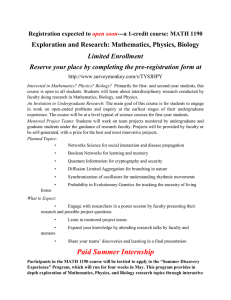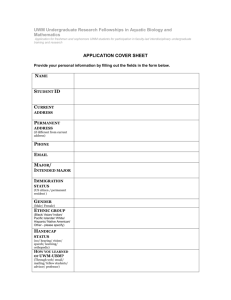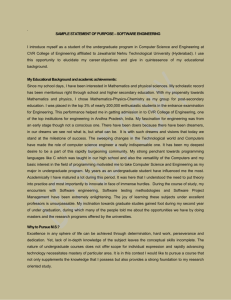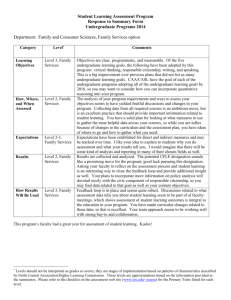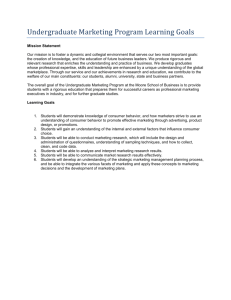Jay Labov/Transforming Undergraduate Education, Learning and
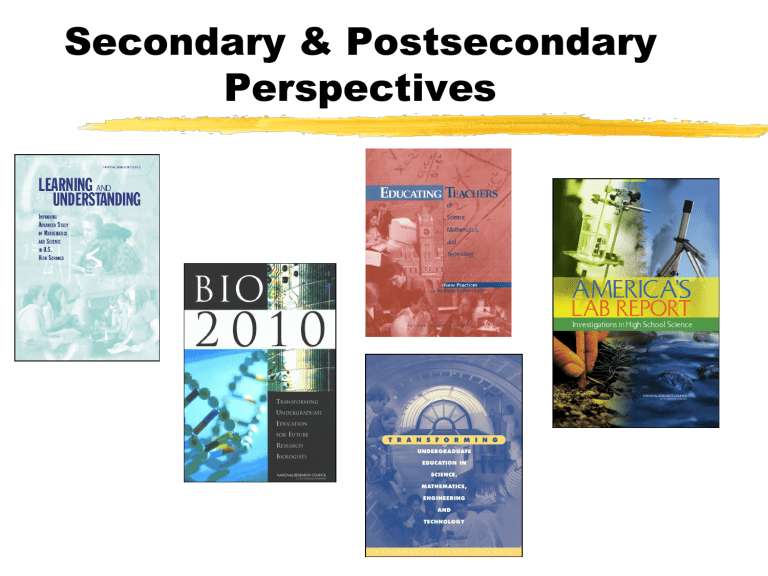
Secondary & Postsecondary
Perspectives
This report has 5 components:
The study committee’s report
Disciplinary panel reports for:
• Biology
• Chemistry
• Mathematics (emphasis on calculus)
• Physics
NSF Awards $1.8 Million to Study High-School Advanced
Placement Work in Math and Science
May 2, 2006 - The National Science Foundation (NSF) awarded a
$1.8 million grant to the College Board to redesign Advanced
Placement Program (AP) courses in biology, chemistry, physics and environmental science. The funds will be used to develop a process for making ongoing changes in the courses and exams to incorporate the latest science developments and leverage best practices in science teaching.
The College Board's AP redesign plan draws on the recommendations of Learning and Understanding:
Improving Advanced Study of Mathematics and Science in U.S. High Schools, issued by the National Research
Council in 2002.
ORIGIN OF STUDY
Jointly requested by the Department of
Education and NSF following the release of 12 th grade data from TIMSS showing that students in the U.S. who had taken calculus or physics scored much lower than their counterparts in most other countries.
CONTENTS
1. INTRODUCTION
2. CONTEXT OF ADVANCED STUDY
3. ADVANCED PLACEMENT PROGRAM
4. INTERNATIONAL BACCALAUREATE PROGRAM
5. OTHER APPROACHES TO ADVANCED STUDY
6. LEARNING WITH UNDERSTANDING: SEVEN PRINCIPLES
7. DESIGNING CURRICULUM, INSTRUCTION, ASSESSMENT, AND
PROFESSIONAL DEVELOPMENT
8. ANALYSIS OF THE AP AND IB PROGRAMS BASED ON LEARNING
RESEARCH
9. ANALYSIS OF AP AND IB CURRICULUM, INSTRUCTION,
ASSESSMENT, AND PROFESSIONAL DEVELOPMENT
10. USES, MISUSES, AND UNINTENDED CONSEQUENCES OF AP
AND IB
11. RECOMMENDATIONS
This percentage was calculated as follows: The numerator includes each public school student in the graduating class of 2008 who earned an AP
Exam score of 3 or higher on an AP Exam at any point in his or her high school years; if a student earned more than one AP Exam grade of 3 or higher, she or he was still only counted once. The denominator is simply the overall number of public school students graduating from high school in
2008, as projected in “Knocking at the College Door” (2008), Western
Interstate Commission for Higher Education.
Race/Ethnicity of Total Student
Population Versus Students Scoring
3 or Higher
Source: http://www.collegeboard.com/html/aprtn/theme_2_reflect_demographics.html#figure_2
FINDINGS AND RECOMMENDATIONS:
Primary Goal of Advanced Study
The primary goal of advanced study in high school should be to help students develop deep understanding of the organizing concepts and principles of a subject domain.
FINDINGS AND RECOMMENDATIONS:
Primary Goal of Advanced Study
The primary goal of advanced study in high school should be to help students develop deep understanding of the organizing concepts and principles of a subject domain.
Accelerated
Study
?
Advanced
Study
FINDINGS AND RECOMMENDATIONS:
Research on Learning
Neither program has used research about how people learn and its applications to improving curriculum, instruction, assessment, and teacher professional development to the extent that they should, although there have been some attempts to do so (e.g., AP calculus.
http://www.nap.edu/catalog/9853.html
http://www.nap.edu/catalog/10019.html
FINDINGS AND RECOMMENDATIONS:
Curriculum
Much greater efforts should be made to align middle and high school curricula, instruction, and assessments in ways that enable do so. all students who wish to pursue advanced study to
The committee supports recommendations of many other organizations that low-level courses in mathematics and science be eliminated from middle and high school curricula.
FINDINGS AND RECOMMENDATIONS:
Assessment of Learning
Assessments for advanced study students should include content and process dimensions of performance and should evaluate depth of understanding in addition to mastery of content knowledge.
Greater emphasis should be placed on measuring learning through multiple assessments rather than relying on end-of-course examinations.
FINDINGS AND RECOMMENDATIONS:
Teacher Qualifications and Education
Schools and districts offering advanced study should provide frequent opportunities for continuing professional development to enable teachers to improve their knowledge of both content and pedagogy.
America’s Lab Report:
Investigations in High School Science
This report by the
National Research
Council’s
Committee on
Undergraduate
Science Education and the activities that led to its production were supported by a grant from the
Exxon Education
Foundation
Transforming Undergraduate Education in Science,
Mathematics, Engineering, and Technology
Directed primarily toward two- and four-year postsecondary institutions.
Transforming Undergraduate Education in
Science, Mathematics, Engineering, and
Technology
Vision statements and implementation strategies address:
Pre-college preparation in science, mathematics, and technology
Quality undergraduate courses, especially at the introductory level
Continual assessment of courses
Roles of SME&T faculty in K-12 teacher preparation and professional development
Institutional roles in promoting and sustaining reform
Roles and responsibilities of graduate and postdoctoral programs
Transforming Undergraduate Education in
Science, Mathematics, Engineering, and
Technology
Pre-college preparation in science, mathematics, and technology
Vision 1: All postsecondary institutions would require all entering students to undertake college-level studies in
SME&T. Entry into higher education would include assessment of students’ understanding of these subjects that is based on the recommendations of national K-12 standards.*
Transforming Undergraduate Education in
Science, Mathematics, Engineering, and
Technology
Quality undergraduate courses, especially at the introductory level
Vision 2: SME&T would become an integral part of the curriculum for all undergraduate students through required introductory courses that engage all students in SME&T and their connections to society and the human condition.
Transforming Undergraduate Education in
Science, Mathematics, Engineering, and
Technology
Continual assessment of courses
Vision 3: All colleges and universities would continually and systematically evaluate the efficacy of courses in SME&T.
Transforming Undergraduate Education in
Science, Mathematics, Engineering, and
Technology
Roles of SME&T faculty in K-12 teacher preparation and professional development
Vision 4: SME&T faculties would assume greater responsibility for the pre-service and in-service education of K-12 teachers.
Transforming Undergraduate Education in
Science, Mathematics, Engineering, and
Technology
Institutional roles in promoting and sustaining reform
Vision 5: All postsecondary institutions would provide the rewards and recognition, resources, tools, and infrastructure necessary to promote innovative and effective undergraduate
SME&T teaching and learning.
Transforming Undergraduate Education in
Science, Mathematics, Engineering, and
Technology
Roles and responsibilities of graduate and postdoctoral programs
Vision 6: Postsecondary institutions would provide quality experiences that encourage all of their graduate and postdoctoral students, and especially those who aspire to careers as postsecondary faculty in SME&T disciplines, to become skilled teachers and current postsecondary faculty to acquire additional knowledge about how teaching methods affect student learning.
Transforming Undergraduate Education in Science,
Mathematics, Engineering, and Technology
Accompanying each vision is a series of strategies for implementing the visions.
Primary audiences for implementation strategies:
- Chief Academic Officers
- Individual faculty and departments
Bio2010:
Tranforming Undergraduate Education for
Future Research Biologists
Research in biology has undergone a major transformation in the last 10 to
15 years…
In contrast, undergraduate biology education is still geared to the biology of the past. Although most colleges and universities require biology majors to enroll in courses in math, chemistry and physics, these subjects are not well integrated into biology courses. Furthermore, most courses, especially those for first-year students, are still primarily lecture-based, and do not convey the exciting reality of biology today.
Bio2010:
Tranforming Undergraduate Education for
Future Research Biologists
• Biology in Context: An
Interdisciplinary Curriculum
• Central Concepts in
• Biology
•
Math and Computer Science
• Chemistry
• Physics
• Engineering
• Energizing the Curriculum
•
Interdisciplinary Approaches
• Building on Concepts through Labs
• Undergraduate Research
• Professional Development in Teaching
